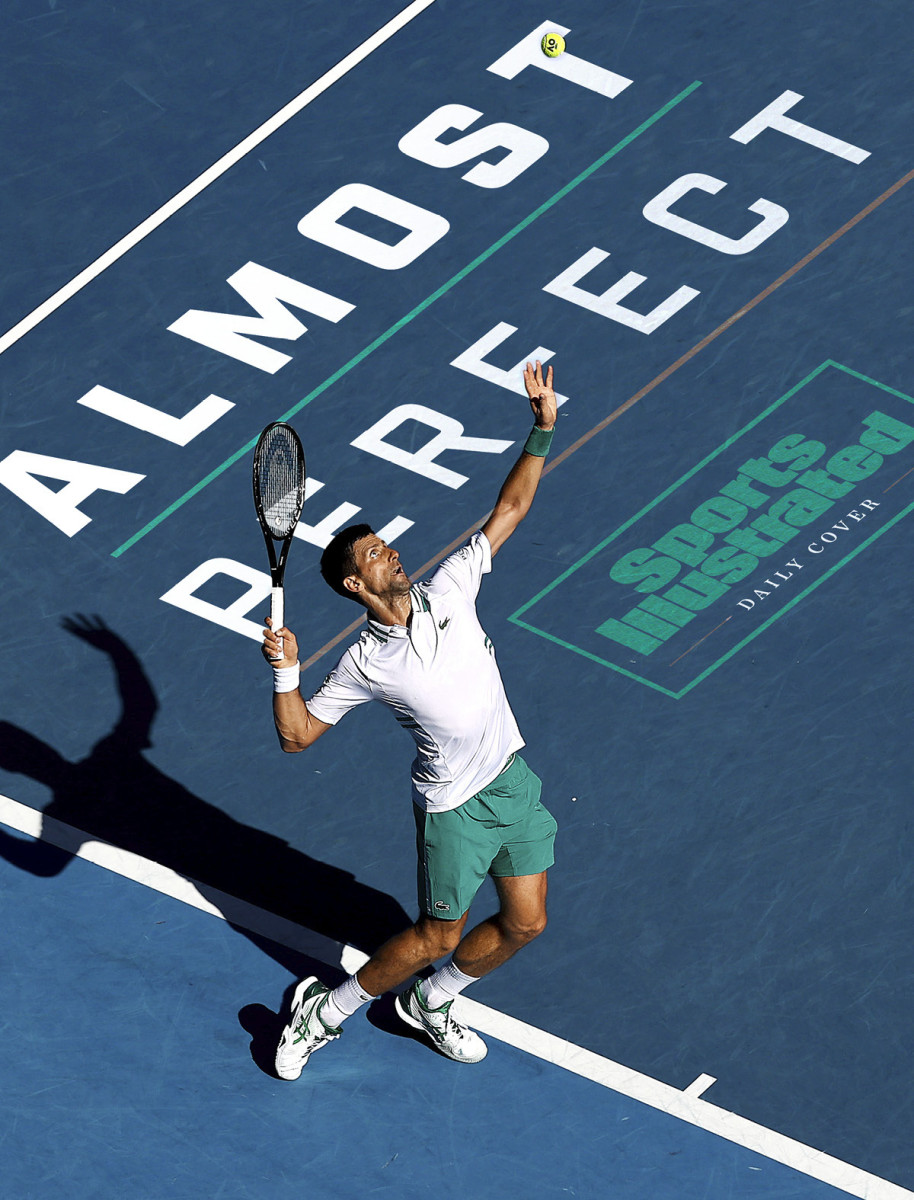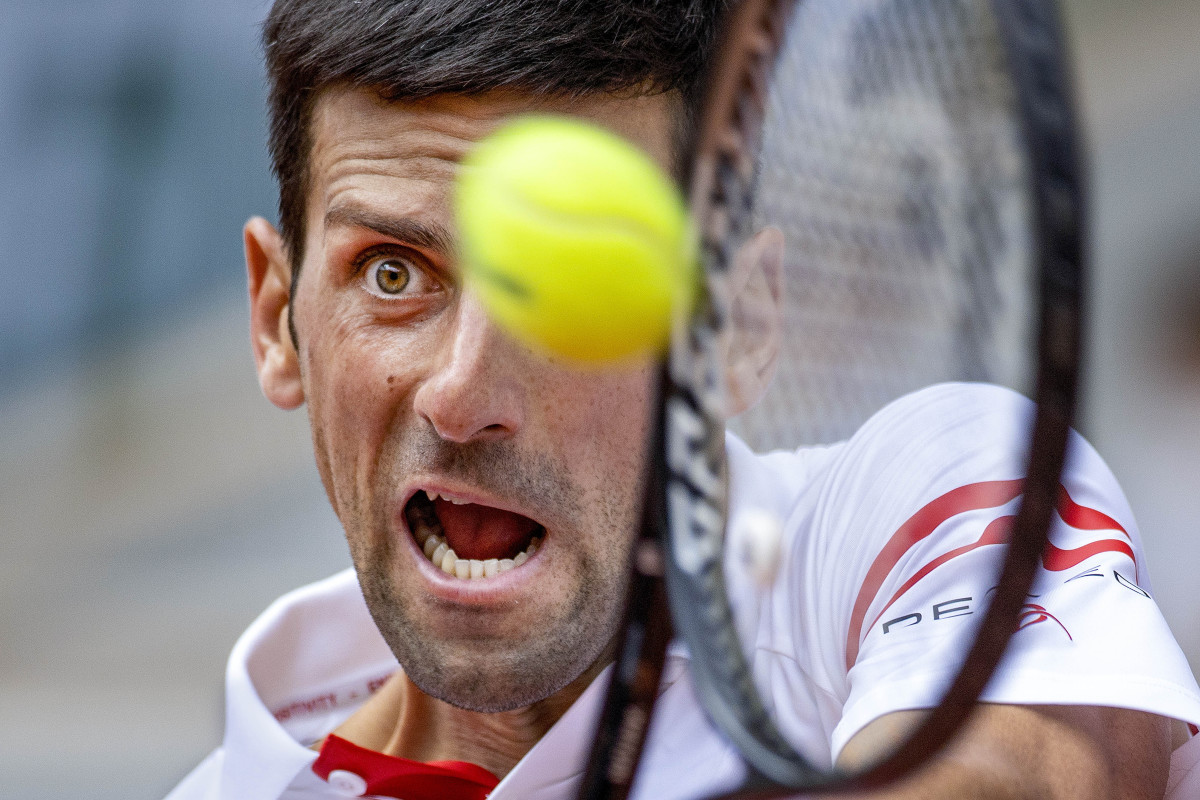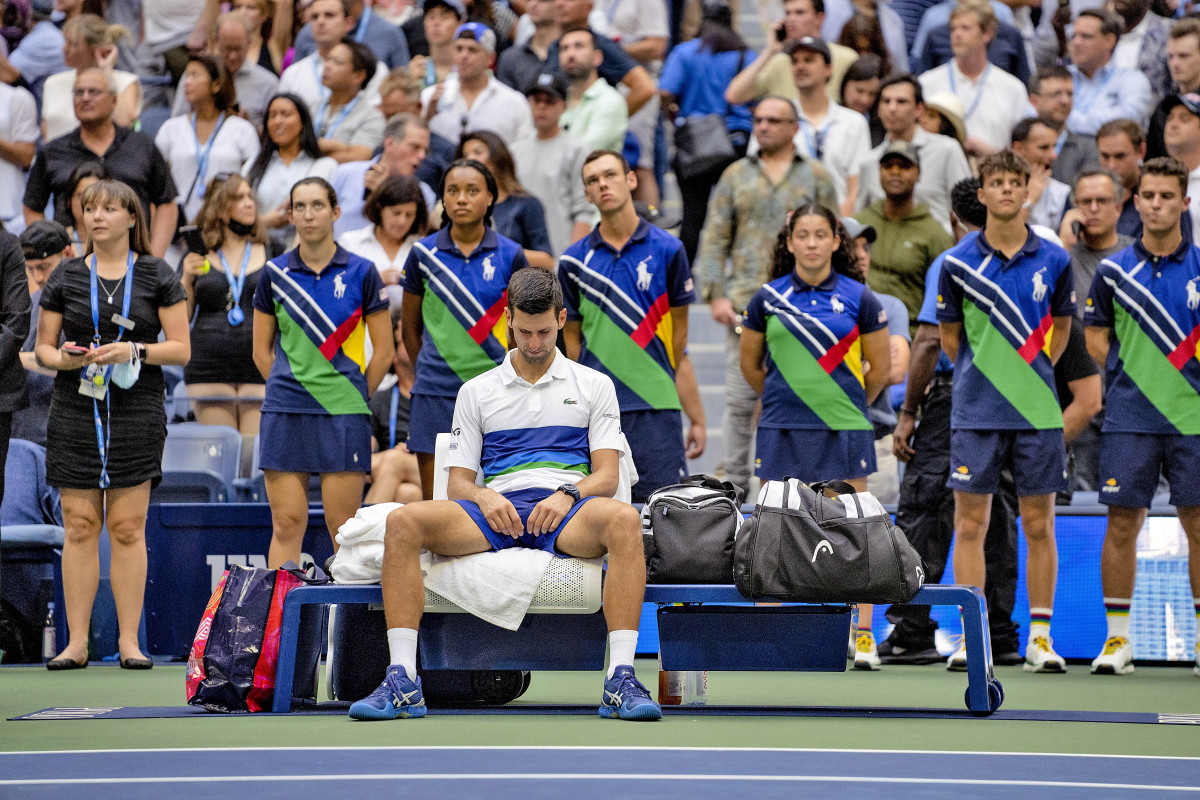Almost Perfect
Trading convenience and action for comfort and solitude, Novak Djokovic usually avoids Manhattan during his annual romps through the U.S. Open. Instead, he stays at the hillside New Jersey estate of the tech-obsessed tennis coach Gordon Uehling, a longtime friend. The grounds include various courts that simulate the sport’s grandest venues—Wimbledon’s Centre Court, Court Philippe-Chatrier at the French Open and Arthur Ashe Stadium in New York—down to the exact same surface specifications and speeds. There are also pools, space-age recovery rooms and acres upon acres of wooded land. Three days before the 2021 U.S. Open began, Djokovic hiked the grounds. Barefoot.
While on that walk, Djokovic was perhaps channeling what, earlier in the summer, he referred to as his wolf energy. “I love the ability to have freedom, space, go around and be in the mountains,” he explained. “Wolves always kind of attracted me. We are—at least most people are—frightened of wolves, but at the same time they are very instinctual animals, and I think very important animals for our ecosystem and for us. I truly try to manifest that kind of determined wolf energy on the court. Balanced with calmness, knowing when to attack and knowing when to rest. So I think those kinds of symbolic explanations [help me] fit with wolves.”
Befitting an athlete who combines the spiritual (and lupine) with the practical, Djokovic is also able to consult a trove of tennis data at Uehling’s estate. Uehling says: “We see the game with 3,800 different shot types and we’re able to really home in on what area needs addressing or areas that the opponent maybe doesn’t like to be addressed. It’s a question-and-answer game. And if somebody is asking a question, you have to come up with the right answer.”

Saying that Djokovic came up with the right answers in 2021 would be akin to saying that, during the year, Elon Musk came up with a bit more wealth. Even by those dizzyingly high Djokovician standards, he outdid himself. In this, the year he turned 34—once thought to be ancient in the dog years of men’s tennis—Djokovic may have been at the peak of his powers. He started at No. 1 and didn’t budge, finishing the season atop the heap for a record seventh time.
He did so mostly by winning three of the four majors (the Australian and French Opens, followed by Wimbledon) and coming within a match of tennis’s holy grail, a
calendar-year Grand Slam, a feat no man has achieved since Rod Laver more than a half century ago.
In 2021, Djokovic pulled even with Roger Federer and Rafael Nadal in men’s tennis’s GOAT rodeo, the three-way rivalry for the right to be declared the best ever. Each man now has 20 major singles titles, a fitting (if temporary) tie among contemporaries for the all-time record. Yet, by virtually any other criteria—weeks at No. 1; head-to-head records; titles at ATP Masters events, the tier underneath majors—Djokovic has surged ahead. And as the youngest of the Big Three, he is the player with the most remaining runway.
Novak Djokovic is not Roger Federer. He doesn’t necessarily play with the kind of easy, fluid grace or whip up flourishes that make it seem like he was touched by the tennis gods. No one compares Djokovic to musicians and artists. Djokovic, unlike Federer, doesn’t play in elegant silence or appear to be transported from another era. And Novak Djokovic is not Rafa Nadal. He is not a converted lefty, doesn’t
drizzle every shot with spin, doesn’t play a sui generis ultraphysical style and doesn’t necessarily play every point with furious, unremitting intensity.
But, while perhaps not as obvious to the casual fan, Djokovic’s assorted tennis superpowers are just as effective.

Among them: He has a magical ability to distort the dimensions of the court. By rights and by rules, a singles tennis court measures 27 feet by 78 feet. But not when you play Djokovic. He hits with such accuracy and depth and uncovers so many angles—jerking around his opponent like a sadistic puppeteer—that their side can seem like a football field.
Meanwhile, he moves so well and anticipates so well that he forces his opponents to aim for the smallest of margins. “You can’t imagine how frustrating it is to hit what you think is a winner or an ace, only to have Novak send it right back,” Andy Roddick said as he watched Djokovic play during the U.S. Open. “When that happens again and again, you go for too much.”
Djokovic is also devoid of weakness. His backhand and forehand are comparably strong. He is perhaps the best returner in tennis history, but he is seldom outserved. In 2021 he committed himself to sharpening his frontcourt game. Asked how he would create a game plan to beat Djokovic these days, Roddick thinks about it, sighs and offers this: “pray.”
And as—and maybe because—Djokovic demoralizes his opponents, he possesses a level of psychic strength usually reserved for spoon-bending mentalists. Almost as a matter of habit, Djokovic finds ways to summon his best tennis when he needs it most. “[Novak is] under so much pressure,” says Dominic Thiem, the 2020 U.S. Open champ, “but he’s shown so many times before that if there’s a big chance, he rarely misses it.”
At majors this year, Djokovic dropped the first set in 10 of his 28 matches. In the cases of other players, even stars, that would trigger an upset alert. In the case of Djokovic: no panic. No problem. It simply meant a longer shift.
One of the few blemishes of Djokovic’s otherwise gilded season came in the finals of the U.S. Open. He was on the threshold of history, a match from the Grand Slam and standing alone on the summit with his 21st major. And . . . he wilted. Pitted against Daniil Medvedev of Russia, the world’s No. 2 player, Djokovic “had little to give,” as he puts it. Whether it was the weight of the occasion, nerves, physical exhaustion or the effectively slappy strokes of the player on the other side of the net, Djokovic fell without his characteristic fight, 6–4, 6–4, 6–4. Before the match had even ended, he was off-loading tears.

In 2015, Serena Williams turned in a season very much akin to Djokovic’s 2021. Also 34, she also won the first three majors; faltered disappointingly at the fourth leg as history beckoned; and despite that sting, was, rightly and rightfully, hailed for one of the towering seasons in the sport’s—in any sport’s—history. Her assorted accolades including being named Sports Illustrated’s 2015 Sportsperson of the Year.
You will notice that Djokovic will receive fewer honors (including SI’s). Why? Perhaps because he’s sometimes his own worst enemy, prone to some scattered unforced errors that can undercut both his popularity and a reputation for sportsmanship. He can overwhelm his rivals, but he often overwhelms himself as well.
Djokovic headed to the Tokyo Olympics bidding for a “Golden Slam,” four majors plus a gold medal. His simple willingness to chance it—flying to Asia, interrupting his schedule and enduring the COVID-19 protocols—amid a potentially historic regular season, made for an admirable move. But Djokovic lost twice—in the semifinals and the bronze-medal match—and lost his temper more often than that, chucking one racket into the stands and smashing another against a net post. This, less than a year after he was defaulted from the 2020 U.S. Open for slapping a ball in anger that happened to strike an official in the throat.
What’s more, during the height of COVID-19 in the summer of 2020, a well-intentioned series of exhibitions Djokovic organized known as the Adria Tour turned into a superspreader event when players traipsed through the Balkans unmasked and cavorted in nightclubs and basement bars. Djokovic was among those who contracted the virus. Apparently unchastened, Djokovic, multiple sources tell SI, declined vaccination during the 2021 season. Asked repeatedly about his status, Djokovic—the same player so rational he consults objective data to analyze 3,800 tennis strokes—has been coy. “I won’t disclose whether I am vaccinated or not. Whatever you say—I have, I have not, maybe, I do not know or I am thinking about it—they will use it against you.” At this writing, it is unclear whether Djokovic will enter the 2022 Australian Open, an event he has won nine times, now that the tournament has a vaccine mandate. This is a man, to mix sports metaphors, with an uncommon knack for scoring own goals.
Here’s both the pity and the offset: Djokovic is, overall, a force of good. He is smart. He is multilingual. He is charismatic. He can talk about international affairs, just as he can talk about wolf energy. Ask him a question, you often get a lengthy answer that doesn’t hew to cliché. Questioned about his winning formula, he smiles, strokes his chin and remarks: “I know that everything matters. At the end of the day, it all affects and contributes to the performance in one way or another. But then also we have to consider the fact that when you’re on the court, also there are some unpredictable things that can happen, whether it’s on the court with your opponent, whether it’s the sensations that you have . . . whatever it is.”
In the most ruthlessly individual of sports, he fancies himself a teammate. When Naomi Osaka announced after the U.S. Open that she would be taking time off to deal with her mental health and her struggles with anxiety, only one male player reached out to her. (Hint: It was the same player who was the first to contact Osaka after she initially made her mental health revelations last May.) Djokovic is also quietly generous. The 2021 U.S. Open featured a record purse, more than $57 million. But the singles winners made “only” $2.5 million, the lowest champion’s purse in nearly a decade. Djokovic is part of a breakaway group that has lobbied for a more equitable payout of prize money. Surely the USTA’s redistribution of wealth, from the tennis squires down to the rank and file, would not have happened without Djokovic’s lobbying against his own financial interests.

Why isn’t Djokovic more popular? is a persistent trope among casual fans. Not so among those deep inside. As the former player and current BBC commentator Mark Petchey put it on Twitter: “Whatever your view of @DjokerNole if you can’t respect the work, sacrifice he has put in and the success he has achieved in arguably the toughest era of men’s tennis ever that is more a reflection of who you are than any negative on him.”
Then of course there is his unsurpassed and unsurpassing tennis. Djokovic finished the year with five titles. Yet the most meaningful and revelatory, ironically, may well have been not one of his three majors, but the Paris Masters event he won indoors on Nov. 7. That marked his return after his disappointment, and it so happened that he faced a rematch with Medvedev in the final. Djokovic lost the first set, and already the narrative was gestating. This guy is in Djokovic’s head. . . . Psychic scar tissue builds. . . . He may be surpassing Federer and Nadal, but Djokovic has a new rival. . . .
Then Djokovic reminded us all—not least himself—why he’s likely to be recalled as the best man ever to have grabbed a racket. He changed tactics, headed to the net a whopping 33 times, leavened offense with defense and closed out a win he described as a “perfect battle,” 4–6, 6–3, 6–3. “I’m not afraid to mix it up,” he said,
referring to his strategic shift but also sending a reminder that there is no better tennis fighter.
If history, math and common sense provide any guide, 2022 will be the year Djokovic produces the equivalent of game-set-match on what’s left of the GOAT debate. He’s coming off perhaps the best year of his career. The seeker will continue seeking. The wolf still bays.
• He Nearly Died on ‘Drive to Survive.’ Now He’s Faster Than Ever.
• Tom Brady Wins the 2021 Sports Illustrated Sportsperson of the Year
• Why Did the WTA Risk Everything for Peng Shuai?
